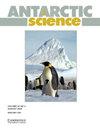基于南极东部大陆架间冰期泥岩地球化学的始新世至渐新世冷却和冰的生长
IF 2
4区 地球科学
Q3 ENVIRONMENTAL SCIENCES
引用次数: 0
摘要
大约3400万年前(Ma)的始新世-渐新世转变标志着全球从温室到冰库的转变,以及南极东部冰盖(EAIS)的建立。在这一气候转变过程中,冰盖的行为是如何在间冰期发生变化的,人们对此知之甚少。我们分析了海洋钻探项目1166号场地Prydz湾始新世晚期间冰期泥岩和威尔克斯陆架综合海洋钻探项目U1360号场地渐新世早期间冰期泥岩的主要、微量和稀土元素数据。这两个地点都有类似的冰川沉积环境。Prydz湾1166号地点的岩相和物源表明Lambert地堑中的晚始新世冰川退缩。古气候指标,包括化学蚀变指数、年平均温度和年平均降水量,显示出始新世末间冰期主要的温暖湿润古气候。相比之下,U1360场地在渐新世早期,物源和间冰期风化机制在物理风化条件下保持相对稳定。这些结果证实,EAIS在始新世晚期间冰川期间基本上周期性退缩,冰下盆地可能在渐新世早期的间冰川期间保持部分冰川作用。本文章由计算机程序翻译,如有差异,请以英文原文为准。
Eocene to Oligocene cooling and ice growth based on the geochemistry of interglacial mudstones from the East Antarctic continental shelf
The Eocene-Oligocene Transition at c. 34 million years ago (Ma) marked the global change from greenhouse to icehouse and the establishment of the East Antarctic Ice Sheet (EAIS). How the ice-sheet behaviour changed during interglacials across this climate transition is poorly understood. We analysed major, trace and rare earth elemental data of late Eocene interglacial mudstone from Prydz Bay at Ocean Drilling Program Site 1166 and early Oligocene interglacial mudstone from Integrated Ocean Drilling Program Site U1360 on the Wilkes Land continental shelf. Both sites have comparable glaciomarine depositional settings. Lithofacies and provenance at Site 1166 in Prydz Bay are indicative of a late Eocene glacial retreat in the Lambert Graben. Palaeoclimate proxies, including the Chemical Index of Alteration, mean annual temperature and mean annual precipitation, show a dominant warm and humid palaeoclimate for the late Eocene interglacial. In contrast, at Site U1360, in the early Oligocene, the provenance and interglacial weathering regime remained relatively stable with conditions of physical weathering. These results confirm that the EAIS substantially retreated periodically during late Eocene interglacials and that subglacial basins probably remained partially glaciated during interglacials in the earliest Oligocene.
求助全文
通过发布文献求助,成功后即可免费获取论文全文。
去求助
来源期刊

Antarctic Science
地学-地球科学综合
CiteScore
3.60
自引率
6.20%
发文量
42
审稿时长
3 months
期刊介绍:
Antarctic Science provides a truly international forum for the broad spread of studies that increasingly characterise scientific research in the Antarctic. Whilst emphasising interdisciplinary work, the journal publishes papers from environmental management to biodiversity, from volcanoes to icebergs, and from oceanography to the upper atmosphere. No other journal covers such a wide range of Antarctic scientific studies. The journal attracts papers from all countries currently undertaking Antarctic research. It publishes both review and data papers with no limits on length, two-page short notes on technical developments and recent discoveries, and book reviews. These, together with an editorial discussing broader aspects of science, provide a rich and varied mixture of items to interest researchers in all areas of science. There are no page charges, or charges for colour, to authors publishing in the Journal. One issue each year is normally devoted to a specific theme or papers from a major meeting.
 求助内容:
求助内容: 应助结果提醒方式:
应助结果提醒方式:


